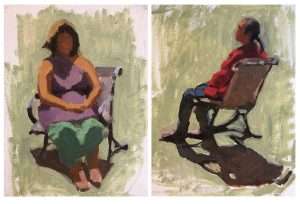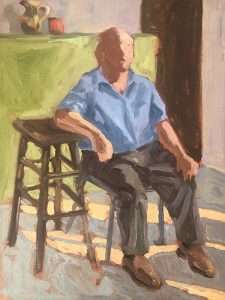Analyze your progress.
If you sailed through this exercise, try more complicated shapes in light and shadow – like a figurative pieces below. If you had some trouble, let’s see where it came up!
We will be moving forward into NOTAN and color harmony in the next section so let’s make sure you are comfortable with getting down the big shapes of light and shadow, mixing the correct color note, and getting it on the canvas.
If you had some trouble with this exercise let’s analyze your painting.
- If you can clearly see what is in light and what is in shadow, and you see the shape of that light and the shape of that shadow, but you are having trouble recreating it on the canvas, the issue may be in the drawing. Set up a still life with more simple shapes. Continue to scribble and sketch on your ipad or on paper and your eye will become trained to see where points intersect and how small pieces come together to create the larger picture – just like any good community. Move onto more complex shapes when the more simple ones are easier to create.
- If your lines (drawing) are good but the painting lacks form, check on your value scale. Value shapes create the form. Is the darkest dark in the darkest object? Is the lightest light in the lightest object?
- If your line and your value structure are good but your color is off determine what’s gone astray. Are your colors too intense? Do you need to “kill a color”. Did you forget to clean your brush and you accidentally killed your color? If you can see the color note but you are having trouble mixing the right color you may want to grab a few more color swatches and play with matching them. There are also color wheel kits that you can buy that will force you to create the full spectrum. I’m sure this is a valuable exercise if you have the patience for it. Or, like many of us, you can also just keep painting. The practice will get you there!
If you are ready, and your friend is willing – sit them in the light.
- Let them find a position that is comfortable for them to hold for 10 minutes at a time.
- Do this exercise in 2-3 sessions and then try another one.
- The position they choose should clearly allow you to see what is in light and what is in shadow.
- Before you ask them to ‘freeze’ in one spot, mix up a color for the light and the shadow of each shape.
- Check the value structure of your color notes – is the light lightest light in the lightest object…
- Start a timer and ask your model to be still. Take a deep breath, and remember that this is practice and it will do beautiful things for your mind – as long as you don’t tense up. Remember, the scene comes in through your eyes, it filters through your beautiful heart and it comes out through your arm as if you are breathing it onto the canvas.
- Sketch out the scene with your transparent earth orange, noticing where points intersect. Be sure to start with the big overall shapes first so the image is composed on the canvas the way you want it to be. If it runs off the edges make sure that it’s intentional and not an accident. It’s ok/common/recommended/happens all the time… to wipe it out and start the sketch again. Once you have the big shapes in, then refine down to the smaller shapes within the big shapes.
- Paint the shapes of light and the shapes of shadow.
The sketches below are from a workshop I took with artist Kevin Macpherson years ago. He’s a great painter and funny guy. We had to mix up the light and shadow colors in advance. Kevin set a timer for 10 minutes and we blocked in the big shapes. This is great practice. You will be amazed at how quickly you move forward when you can block in your big shapes. There is no detail for variation in the light or in the shadow here, just shapes of light and shapes of shadow in the (basically) correct color note.

The oil sketch below is from a few years earlier when I studied in Italy for a month. I showed up with photographs that I wanted to work from and I was swiftly told to put them away. It was my first real experience of painting from life and it was really valuable. I had a slew of old men sit in the square for me and I did my best to create light and show shapes to catch them on canvas. I drank lots of coffee and red wine. I laughed with other students. I wrote blog posts. I missed my family. And I really began to understand how to paint. There is nothing wrong with using photos to reference or remind you of a place and time, but if you learn to paint from life you will understand how to paint from photos -even if they are problematic photos. We will cover more of that as we move forward. The fellow below sat for about an hour. We chose to work inside because the sun was too strong for both of us. I still love the shapes in this little piece all these years later. A painting does not have to be complicated to please your eye. I can’t wait to see what you all paint. Ciao!

